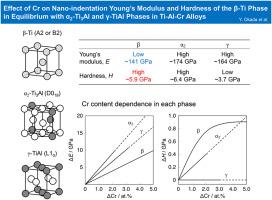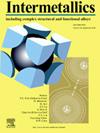铬对 Ti-Al-Cr 合金中与α2-Ti3Al 和 γ-TiAl 相平衡的 β-Ti 相的纳米压痕杨氏模量和硬度的影响
IF 4.3
2区 材料科学
Q2 CHEMISTRY, PHYSICAL
引用次数: 0
摘要
通过化学成分分析和纳米压痕法,定量评估了 Ti-Al-Cr 三元合金中与α2-Ti3Al(D019)和γ-TiAl(L10)相平衡的β-Ti(bcc 或 B2)组成相的杨氏模量和硬度,以确定铬浓度对β相机械性能的依赖性。一种标称成分为 Ti-43Al-3Cr (at.%) 的合金在 1373 K 下通过平衡热处理分解为 β、α2 和 γ 三相,其化学成分分别为 Ti-37.2Al-5.2Cr、Ti-38.9Al-2.2Cr 和 Ti-47.4Al-1.4Cr。β 相的杨氏模量为 141 ± 5 GPa,与其他两相 α2 相(174 ± 9 GPa)和 γ 相(164 ± 15 GPa)相比,杨氏模量更小,取向依赖性更低。相比之下,β 相的硬度为 5.9 ± 0.3 GPa,比 α2 相(6.4 ± 0.8 GPa)稍软,但比γ 相(3.7 ± 0.6 GPa)硬得多。合金 Ti-44Al-4Cr 和 Ti-45Al-6Cr 由 β 和 γ 两相组成,这两种合金中 β 相的化学成分分别为 Ti-36.5 Al-8.5 Cr 和 Ti-36.3 Al-13.9 Cr,铝的浓度几乎相同。随着铬含量的增加,后一种成分的 β 相的杨氏模量和硬度分别变为 158 GPa 和 6.7 GPa。这些结果表明,与其他两种相相比,固溶铬对β相杨氏模量的影响相对较弱,而对硬度的影响较强。本文章由计算机程序翻译,如有差异,请以英文原文为准。

Effect of Cr on nano-indentation Young's modulus and hardness of the β-Ti phase in equilibrium with α2-Ti3Al and γ-TiAl phases in Ti-Al-Cr alloys
Young's modulus and hardness of the constituent phases of β-Ti (bcc or B2), in equilibrium with α2-Ti3Al (D019) and γ-TiAl (L10) phases in Ti-Al-Cr ternary alloys were quantitatively evaluated in terms of the chemical composition analysis and nano-indentation method, in order to identify the Cr concentration dependence on the mechanical properties of the β phase. An alloy with a nominal composition of Ti-43Al-3Cr (at.%) decomposes into the three phases of β, α2, and γ by equilibrium heat treatment at 1373 K, with chemical composition of Ti-37.2Al-5.2Cr, Ti-38.9Al-2.2Cr, and Ti-47.4Al-1.4Cr, respectively. The β phase shows a Young's modulus of 141 ± 5 GPa, smaller and less orientation dependent than the other two phases of α2 (174 ± 9 GPa) and γ phases (164 ± 15 GPa). In contrast, the β phase has a hardness of 5.9 ± 0.3 GPa, slightly softer than the α2 phase (6.4 ± 0.8 GPa) but much harder than the γ phase (3.7 ± 0.6 GPa). The alloys Ti-44Al-4Cr and Ti-45Al-6Cr consist of two phases of β and γ phases, and the chemical composition of the β phase in these two alloys is Ti-36.5 Al-8.5 Cr and Ti-36.3 Al-13.9 Cr, respectively, with nearly the same Al concentration. The Young's modulus and hardness of the β phase with the latter composition become 158 GPa and 6.7 GPa, respectively, with increasing Cr content. These results found that the effect of solid solution Cr on the Young's modulus for β phase is relatively weak, and that on the hardness is strong, in comparison with that for the other two phases.
求助全文
通过发布文献求助,成功后即可免费获取论文全文。
去求助
来源期刊

Intermetallics
工程技术-材料科学:综合
CiteScore
7.80
自引率
9.10%
发文量
291
审稿时长
37 days
期刊介绍:
This journal is a platform for publishing innovative research and overviews for advancing our understanding of the structure, property, and functionality of complex metallic alloys, including intermetallics, metallic glasses, and high entropy alloys.
The journal reports the science and engineering of metallic materials in the following aspects:
Theories and experiments which address the relationship between property and structure in all length scales.
Physical modeling and numerical simulations which provide a comprehensive understanding of experimental observations.
Stimulated methodologies to characterize the structure and chemistry of materials that correlate the properties.
Technological applications resulting from the understanding of property-structure relationship in materials.
Novel and cutting-edge results warranting rapid communication.
The journal also publishes special issues on selected topics and overviews by invitation only.
 求助内容:
求助内容: 应助结果提醒方式:
应助结果提醒方式:


